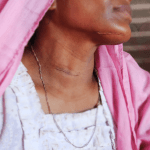On the eve of the second anniversary of the August 2017 campaign of extreme violence by Myanmar security forces against Rohingya civilians in northern Rakhine state, the experiences of “Chesa” and Chit” (not their real names) recall the brutality of that campaign.
“Chesa,” a 60-year-old Rohingya woman, and “Chit,” her 20-year-old daughter, were interviewed by Physicians for Human Rights (PHR) investigators in Cox’s Bazar, Bangladesh last year and recounted how, in September 2017, security forces entered their village and forced Chit’s 20-year-old pregnant cousin and her husband into a field. They killed the husband immediately and then raped the cousin, after which they mutilated her breasts with a knife and killed her.
Those horrors are emblematic of a vicious, widespread, and systematic targeting of the Muslim Rohingya population in northern Rakhine state by Myanmar security forces in a weeks-long orgy of violence that began on August 25, 2017. That’s when security forces attacked hundreds of Rohingya villages, massacring thousands of their residents and burning their homes to the ground. As of January 2019, the violence and ongoing abuses had killed at least 10,000 Rohingya civilians and prompted approximately 740,000 others to flee for their lives to Cox’s Bazar in neighboring Bangladesh, where they remain.
Of 114 Rohingya survivors interviewed by PHR during four separate field investigations to Cox’s Bazar in 2017 and 2018, 11 (9.6 percent) said that they had been the subject of some kind of deliberate bodily mutilation or had witnessed Myanmar security forces mutilating others. The victims of those mutilations suggest that the security forces intentionally targeted women and girls – particularly those who were pregnant – with mutilations of their breasts, genitals, or other body parts, often while or after they were raped. But men, including religious or community leaders, were also targets for mutilation or decapitation. Due to the deeply brutal and stigmatizing nature of injuries like genital mutilation – and the fact that PHR did not ask specific questions about this kind of violence – they are likely underreported.
PHR’s findings on sexual violence and mutilation of Rohingya civilians by Myanmar security forces are consistent with documentation by the United Nations Fact-Finding Mission (FFM). In September 2018, the FFM reported that Myanmar security forces used sexual violence – often including gang rape – on a mass scale against Rohingya women and girls. That report concluded that rape and other forms of gender-based violence “were used as a form of torture, to terrorize the community and as a tactic of war.” The Myanmar government rejected the report’s findings as “false allegations,” and, to date, has failed to conduct impartial or independent investigations into these events or allow the UN or other bodies to do so.
The UN report also noted the widespread use of sexual violence, including genital and other bodily mutilation, which served Myanmar security forces as a tool “akin to branding.” A September 2018 United States State Department report on the targeted violence against the Rohingya documented that 10 percent of the 1,024 Rohingya surveyed for the report stated that they had witnessed mutilations of Rohingya citizens, including “the cutting and spreading of entrails, severed limbs or hands/feet, pulling out nails or burning beards and genitals to force a confession, or being burned alive.”
Those atrocities come as no surprise to long-time foreign observers of the activities of the Myanmar military, or Tatmadaw. The Tatmadaw has long been synonymous with perpetrating with impunity egregious human rights abuses against the country’s ethnic minorities as part of a “culture of recreational sadism within the Burmese Army that has defined their counter-insurgency practice for decades.” The Tatmadaw is not alone in committing such abuses. Security forces and combatants have long used mutilation as a tactic of terror in conflicts in areas including Colombia, Haiti, Liberia, and Sierra Leone. Bodily mutilation carries immediate and long-term effects on targeted populations by inflicting fear, shame, and humiliation on both victims and witnesses to such brutality. On the individual level, these intentional injuries, targeted at civilians, can have profound physiological and psychological effects on both victims and witnesses.
The medical consequences of mutilations are devastating. The intentional mutilation and amputation of body parts outside of a medical facility, without anesthesia, and using non-sterile tools, such as knives and machetes, can cause severe pain, bleeding, hemorrhagic shock, and death. It can also cause infection, possibly leading to gangrene and sepsis (disseminated infection). Studies on the mental health consequences of civilian-targeted, traumatic conflict-related injuries have shown significantly higher rates of post-traumatic stress disorder, anxiety, and depression than in the general population. A compounding factor is the general lack of access to rehabilitation, pain relief, and mental health services in refugee settings and in low-income countries, such as Bangladesh and Myanmar.
The mutilation of the genitalia and other reproductive organs of both males and females should not be confused with harmful culturally-bound or ceremonial practices, such as male circumcision or female genital mutilation or cutting (FGM/C), but should be regarded as a deliberate attempt to maim, shame, and humiliate. Beyond the immediate risk of bleeding, pain, and infection, such sadistic actions can also affect future fertility of both men and women, and thus can be interpreted as actions meant to send a message about reproduction and procreation of a specific ethnic group.
The widespread and systematic use of bodily mutilation by Myanmar security forces against Rohingya civilians constitutes a crime against humanity. PHR supports recommendations by the UN Fact-Finding Mission to refer Myanmar to the International Criminal Court or an ad hoc criminal tribunal to further investigate these crimes. Among the victims who should not be forgotten: those who were subjected to or witnessed mutilations, the brutal result of which will remain seared into their memories and onto their bodies for years to come.

